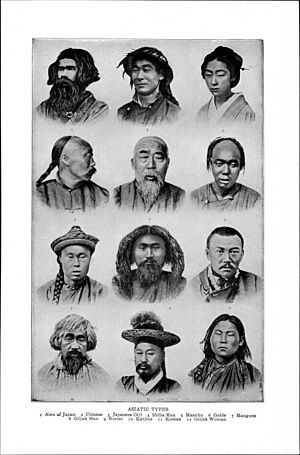Mongoloid (race) facts for kids

The word Mongoloid was a term used in the past to describe a group of people based on their physical features and where they came from. This idea of dividing people into "races" like Mongoloid, Caucasoid, and Negroid was developed in the 1700s. It included people from places like East Asia, Central Asia, Southeast Asia, North Asia, South Asia, the Arctic, the Americas, and the Pacific Islands.
Today, most scientists who study people, called anthropologists, do not use the term "Mongoloid." They believe that these old ways of grouping people are not accurate or helpful. Modern science shows that human groups are much more complex and diverse than these old terms suggested.
The word "Mongoloid" also had a second, very different use. Until the late 1900s, people with Down syndrome were sometimes wrongly called "Mongoloids." This term is now considered very offensive and inaccurate. Down syndrome is a genetic condition that can affect anyone, no matter where their family comes from. It has nothing to do with the regions or groups of people described by the older racial term.
Contents
Understanding Old Race Ideas
In the 1700s, some early scientists, called ethnologists, tried to sort people into different groups. They looked at things like skin color, hair type, and facial features. They came up with three main groups:
- Mongoloid: This group included people from many parts of Asia, the Americas, and the Pacific Islands.
- Caucasoid: This group generally included people from Europe, North Africa, and parts of Western Asia.
- Negroid: This group usually included people from Sub-Saharan Africa.
Why These Ideas Changed
Over time, scientists learned much more about human genetics and history. They found that people are much more mixed and connected than these simple groups suggested. The idea of distinct "races" based on physical looks became less common in science. Most modern anthropologists now agree that these old terms do not truly reflect human diversity. They prefer to study human populations based on genetics, culture, and geography, rather than outdated racial categories.
How Forensic Science Uses Old Terms
Sometimes, in forensic science, which helps solve crimes, older terms like "Mongoloid" might still be used. This is usually when forensic anthropologists are trying to identify a person's likely ancestry from skeletal remains. However, even in this field, many experts are moving away from these terms. They prefer more precise and less misleading ways to describe human variation.
The Harmful Use of "Mongoloid"
It is important to know that the word "Mongoloid" was also used in a very hurtful way. For many years, people with Down syndrome were called "Mongoloids" or their condition was called "Mongolian idiocy." This was because some people thought their facial features looked similar to those of people from East Asia.
This connection was completely wrong and very offensive. Down syndrome is a genetic condition. It happens when a person has an extra copy of chromosome 21. This can happen to anyone, from any background or part of the world. Using the term "Mongoloid" for Down syndrome caused a lot of pain and misunderstanding. It also incorrectly linked a medical condition to a specific group of people. Today, this term is no longer used in medicine or by respectful people.

